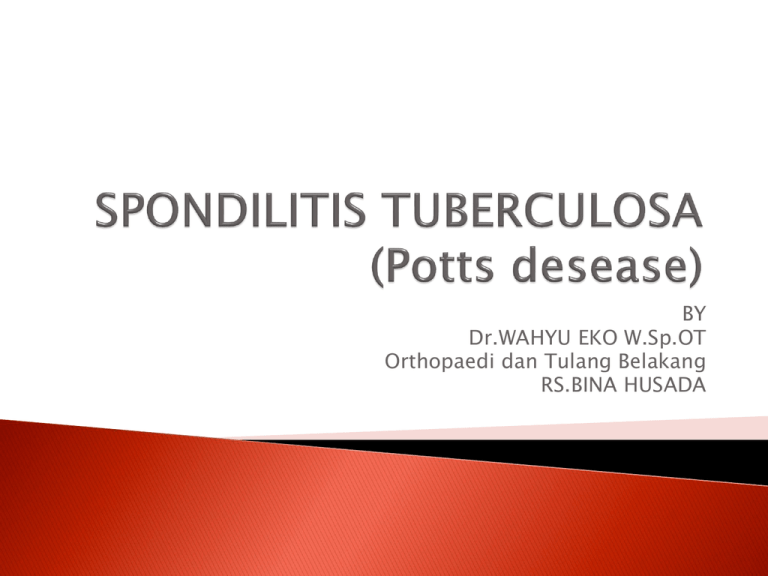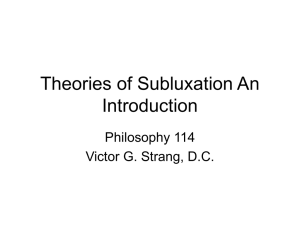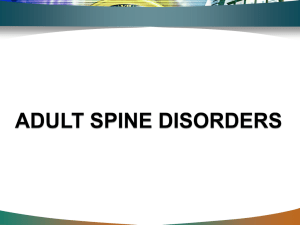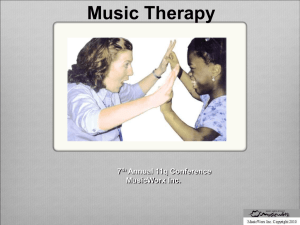
BY
Dr.WAHYU EKO W.Sp.OT
Orthopaedi dan Tulang Belakang
RS.BINA HUSADA
www.dokterbedahtulang.com
Pott disease ( Spondilitis Tubercolosis)
merupakan penyakit manusia tertua.
Ditemukan dari jaman Batu, mummi Mesir
kuno dan Peru.
In 1779, Percivall Pott, pemberi nama
penyakit ini, menjelaskan perjalanan penyakit
ini.
Dgn adanya Obat Antituberculous dan perbaikan
ukuran kesehatan masyarakat----spinal
tuberculosis di negara maju sangat jarang.
Di negara sedang berkembang ----- masih
banyak. (bogor)
Spondilitis TBC ---- menyebakan masalah serius
karena adanya gangguan motorik dan sensorik.
Pemberian OAT dan operasi ____ bisa mengontrol
penyakit ini.
Asal Potts desease: secundair karena
osteomyelitis dan Arthritis TB
Bisa Lebih 2 vertebrae .
Melibatkan bagian anterior dari Corpus Vertebrae
…..discus vertebralis Rusak.
Pada orang dewasa discus rusak akibat infeksi
dari VB
Pada anak2, Lesi primer bisa di Discus Inter
vertebralis.
Kerusakan CV yang progresive menyebabkan
CV kolaps dan menyebakan kyphosis.
Saluran Spinal menyempit ok abses, jaringan
granulasi ‘….. Menekan spinal cord====
defisit Neurologi.
Terutama bagian thorakal=== lebih kyphotic.
Cold absces== infeksi menyebar ke ligament
dan soft tisue.
Abscesses di lumbar==turun ke bawah ke
Psoas === trigonum femoral === ke kulit.
Foto AP
Foto Lat
United States
Masih ada tahun 1980-1990….. Turun drastis
Spondilitis TBC==== 40-50% .4
musculoskeletal tuberculosis
4International
Pott disease=== 1-2 persen kasus total TBC
In the Netherlands between 1993 and 2001,
tuberculosis of the bone and joints accounted
for 3.5% of all tuberculosis cases
@ Pott disease penyakit musculo skeletal yang
paling berbahaya. Karena menyebakan
kerusakan tulang, deformitas dan paraplegi.
Thoracic and lumbosacral spine.== Lower
thoracic vertebrae (40-50%),
the lumbar spine (35-45%).
Cervical spine 10%
Race
Tergantung riwayat kontak TBC.
Sex
male-to-female ratio of 1.5-2:1).
Age
Dewasa, dewasa muda dan anak2.
The presentation of Pott disease depends on the
following:
◦ Stadium penyakit
◦ Lokasi Kelainan
◦ Adanya komplikasi seperti neurologic deficits,
abscesses, or sinus tracts
Dilaporkan rata2 : Durasi simptom sampai
diagnosis > 4 bulan.
Sakit Pinggang yang lama, gejala awal yang
paling umum
Bisa Spinal dan Radicular
Demam dan Berat Badan Turun
Neurologic abnormalities : 50% of cases
Kompresi spinal cord diikuti paraplegia, paresis,
impaired sensation, nerve root pain, and/or
cauda equina syndrome.
Spondilitis TBC di cervical – Jarang tapi serius
komplikasinya,
◦ Pain and stiffness.
◦ Patients with lower cervical spine disease can present
with dysphagia or stridor.
◦ Symptoms can also include torticollis and hoarseness,
◦ neurologic deficits.
The examination :
◦ Pemeriksaan Tulang belakang.
◦ Inspeksi kulit adakah sinus?
◦ Abdominal evaluation for subcutaneous flank mass
◦ Pemeriksaan Neurologi motorik dan sensorik.
Pott diseases menyebabkan deformitas tulang
belakang (kyphosis).
Large cold abscesses of paraspinal tissues or
psoas muscle may protrude under the
inguinal ligament and may erode into the
perineum or gluteal area.
Defisit Neurologi
Upper cervical spine can cause rapidly
progressive symptoms.
◦ Retropharyngeal abscesses occur in almost all
cases.
◦ Neurologic manifestations occur early and range
from a single nerve palsy to hemiparesis or
quadriplegia.
(62-90% of patients in reported series6, 7) have
no evidence of extraspinal tuberculosis
Penegakkan diagnosisi : imaging studies,
microbiology, and anatomic pathology
DIFFERENTIAL DIAGNOSIS
Actinomycosis
Blastomycosis
Brucellosis
Candidiasis
Cryptococcosis
Histoplasmosis
Metastatic Cancer, Unknown Primary Site
Miliary Tuberculosis
Multiple Myeloma
Mycobacterium Avium-Intracellulare
Mycobacterium Kansasii
Nocardiosis
Paracoccidioidomycosis
Septic Arthritis
Spinal Cord Abscess
Tuberculosis
Other Problems to be Considered
Spinal tumors
Lab Studies
Tuberculin skin test (purified protein
derivative [PPD]) results are positive in 8495%
LED
Microbiology studies
CT-guided procedures
Radiography
Lytic destruction of anterior portion of vertebral body
Increased anterior wedging
Collapse of vertebral body
Reactive sclerosis on a progressive lytic process
Enlarged psoas shadow with or without calcification
◦ Additional radiographic findings may include the
following:
Vertebral end plates are osteoporotic.
Intervertebral disks may be destroyed.
Vertebral bodies show variable degrees of destruction.
Fusiform paravertebral shadows suggest abscess
formation.
Bone lesions may occur at more than one level.
◦ CT scanning provides much better bony detail of
irregular lytic lesions, sclerosis, disk collapse, and
disruption of bone circumference.
◦ Low-contrast resolution provides a better
assessment of soft tissue, particularly in epidural
and paraspinal areas.
◦ CT scanning reveals early lesions and is more
effective for defining the shape and calcification of
soft-tissue abscesses.
◦ In contrast to pyogenic disease, calcification is
common in tuberculous lesions.
◦ MRI is the criterion standard for evaluating diskspace infection and osteomyelitis of the spine and
cold Abcess.
◦ MRI ==== Lihat neural compression.15, 1
◦
6
◦ MRI findings useful to differentiate tuberculous
spondylitis from pyogenic
Other Tests
Radionuclide scanning findings are not
specific for Pott disease.
Gallium and Tc-bone scans yield high falsenegative rates (70% and up to 35%,
respectively).18
Use a percutaneous CT-guided needle biopsy
of bone lesions to obtain tissue samples.
◦ This is a safe procedure that also allows therapeutic
drainage of large paraspinal abscesses.
◦ Obtain a tissue sample for microbiology and
pathology studies to confirm diagnosis and to
isolate organisms for culture and susceptibility.
Some cases of Pott disease are diagnosed
following an open drainage procedure (eg,
following presentation with acute neurologic
deterioration
Microbiologic
Patologi Anatomi : Gold standart
Gross pathologic : exudative granulation
tissue with abscesses.
caseating necrosis.
Pott disease : Prolonged bed rest or a body
cast. Pott disease carried a mortality rate of
20%, and relapse was common
(30%)==before OAT
Thoracolumbar spine should be treated with
combination chemotherapy for 6-9 months.19
Many experts still recommend chemotherapy
for 9-12 months.
4-drug regimen
Isoniazid and Rifampin (9-12 bln)
Tambahan first 2 months (first-line drugs),
pyrazinamide, ethambutol, and streptomycin.
The use of second-line drugs is indicated in
cases of drug resistance (cyprofloksasin)
TREATMENT
1.Kemoterapi dan konservative
2.Kemoterapi dan Operasi
◦ Neurologic deficit (acute neurologic deterioration,
paraparesis, paraplegia)
◦ Spinal deformity with instability or pain
◦ No response to medical therapy (continuing
progression of kyphosis or instability)
◦ Large paraspinal abscess
◦ Nondiagnostic percutaneous needle biopsy sample
Anterior radical focal debridement and
posterior stabilization with instrumentation.24,
10
Involves the cervical spine, the following
factors justify early surgical intervention:
◦ High frequency and severity of neurologic deficits
◦ Severe abscess compression that may induce
dysphagia or asphyxia
◦ Instability of the cervical spine
Orthopedic surgeons
Neurosurgeons
Rehabilitation teams
JAMAN DAHULU
plaster beds, plaster jackets, and braces are
still used.
Cast or brace immobilization was a traditional
form of treatment but has generally been
discarded. Patients with Pott disease should
be treated with external bracing.
A 3-drug regimen usually includes isoniazid,
rifampin, and pyrazinamide.
The use of second-line drugs is indicated in
cases of drug resistance.
Lama Pengobatan 9-12
Further Inpatient Care
Once the diagnosis of Pott disease is established and
treatment is started, the duration of hospitalization
depends on the need for surgery and the clinical stability
of the patient.
Further Outpatient Care
Patients with Pott disease should be closely monitored to
assess their response to therapy and compliance with
medication. Directly observed therapy may be required.
The development or progression of neurologic deficits,
spinal deformity, or intractable pain should be considered
evidence of poor therapeutic response. This raises the
possibility of antimicrobial drug resistance as well as the
necessity for surgery.
Because of the risk of deformity
exacerbations, children with Pott disease
should undergo long-term follow-up until
their entire growth potential is completed.25
Abscess
Spine deformities
Neurologic deficits and paraplegia
Therapy compliance and drug resistance are
additional factors that significantly affect
individual outcomes.
Paraplegia : responds well to chemotherapy.
If medical therapy does not result in rapid
improvement, operative decompression will
greatly increase the recovery rate.
Paraplegia can manifest or persist during
healing because of permanent spinal cord
damage.








